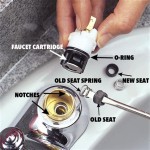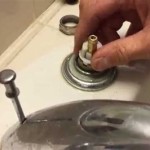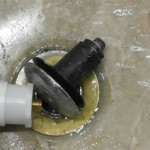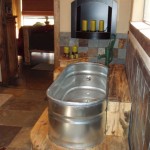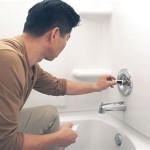Brown Water Coming Up From Bathtub Drain: Causes and Solutions
The appearance of brown water emerging from a bathtub drain is an unsettling and potentially concerning issue that can indicate problems within a plumbing system. This phenomenon, characterized by discolored water flowing backward into the bathtub, often signals underlying issues that, if left unaddressed, can lead to more significant and costly repairs. Understanding the potential causes of this issue and the appropriate steps to take are crucial for maintaining a healthy and functional plumbing system.
Brown water in a bathtub typically indicates the presence of sediment, rust, or other contaminants within the water supply or drainage system. The specific color intensity and accompanying characteristics, such as odor or particulate matter, can offer clues as to the source and nature of the problem. While the appearance of brown water might be intermittent, persistent reoccurrence necessitates investigation and remediation to prevent further damage and ensure water quality.
The issues responsible for brown water can range from relatively simple problems solvable by homeowners to situations requiring the intervention of a qualified plumbing professional. Attempting to diagnose and address the issue without proper understanding can potentially worsen the situation or lead to incorrect solutions. Therefore, a systematic approach to identifying the potential causes and implementing appropriate remedies is essential.
Identifying the Potential Causes
Several factors can contribute to the appearance of brown water emanating from a bathtub drain. These causes can generally be categorized into issues related to the water supply, problems within the drainage system, or a combination of both. A careful assessment of the situation is necessary to isolate the most likely culprit.
Water Main Issues: Problems with the municipal water supply can affect the water quality throughout a neighborhood or even an entire city. Construction activities, water main breaks, or routine maintenance can dislodge sediment and rust accumulated within the pipes. When the water flow is disrupted, this sediment can be stirred up and carried into homes through the water supply lines. This is especially noticeable in older systems with cast iron pipes that are prone to corrosion.
If other fixtures in the house, such as faucets and toilets, also exhibit brown water, the problem is likely related to the water main. Contacting the local water authority is recommended to inquire about any recent disturbances or scheduled maintenance in the area. The water authority can often provide information about the cause of the discoloration and the estimated timeframe for resolution.
Corroded Pipes: Within a home's plumbing system, older galvanized steel or cast iron pipes are susceptible to corrosion over time. As these pipes age, the interior surfaces can rust, releasing iron oxide into the water. This rust can then manifest as brown or reddish-brown water, particularly when a tap is first turned on or after a period of disuse. The bathtub, being a lower-lying fixture, can be a common point for the accumulation of this sediment and the manifestation of discolored water.
The presence of brown water consistently or after extended periods of disuse strongly suggests pipe corrosion. While pipe replacement is the most effective long-term solution, it is a significant undertaking. In the interim, flushing the affected pipes regularly can help to minimize the discoloration, but it will not eliminate the underlying problem. Filtering the water at the point of use can also improve its quality, but this does not address the corrosion within the pipes themselves.
Sediment Buildup in the Water Heater: Water heaters accumulate sediment over time as minerals present in the water precipitate and settle at the bottom of the tank. This sediment can include rust, calcium carbonate, magnesium, and other debris. When the water heater is used frequently or when the sediment layer becomes excessively thick, the sediment can be stirred up and carried into the hot water lines. This can result in brown water appearing in fixtures connected to the hot water supply, including bathtubs.
To determine if the water heater is the source of the problem, check if the brown water only appears when using hot water. If this is the case, flushing the water heater is a relatively simple maintenance procedure that can remove accumulated sediment. The process involves turning off the power and water supply to the heater, connecting a hose to the drain valve, and allowing the water to drain until it runs clear. Regular flushing, typically once or twice a year, can help prevent sediment buildup and maintain the water heater's efficiency.
Drainage System Blockages: While less directly related to water quality, blockages within the drainage system can indirectly contribute to the appearance of brown water. A partial clog in the drainpipe can restrict the flow of water, causing it to back up. As the water sits stagnant in the pipes, it can accumulate sediment and debris. When a large volume of water is released, such as when emptying a bathtub, this accumulated sediment can be pushed back up through the drain, resulting in brown water emerging from the drain.
Signs of a drainage system blockage include slow draining, gurgling sounds from the drain, or the presence of foul odors. Identifying and clearing the blockage can involve using a plunger, drain snake, or chemical drain cleaner. However, chemical drain cleaners should be used with caution, as they can damage pipes if used improperly or excessively. If the blockage is severe or recurring, it may be necessary to consult a plumbing professional to identify and remove the obstruction.
Troubleshooting Steps to Identify the Source
When confronted with brown water emanating from a bathtub drain, a systematic approach to troubleshooting can help pinpoint the source of the problem. The following steps provide a framework for investigation:
Isolate the Issue: Determine if the brown water is present in other fixtures in the house. If the problem is limited to the bathtub, it suggests a localized issue within the bathtub's plumbing or drainage system. If other fixtures are affected, the problem is likely related to the water main or the hot water heater.
Check Hot vs. Cold Water: Determine if the brown water appears when using hot water, cold water, or both. If it only appears with hot water, focus on the water heater as the potential source. If it appears with both hot and cold water, the problem is likely related to the water main or the pipes leading to the bathtub.
Inspect for Drainage Issues: Check the bathtub drain for signs of blockage, such as slow draining or gurgling sounds. If a blockage is suspected, attempt to clear it using a plunger or drain snake. Observe if clearing the blockage resolves the issue of brown water.
Contact the Water Authority: If the problem appears to be related to the water main, contact the local water authority to inquire about any recent disturbances or scheduled maintenance in the area. The water authority can provide information about the water quality and any potential issues affecting the water supply.
Inspect Visible Pipes: If accessible, inspect the visible pipes leading to the bathtub for signs of corrosion or damage. Look for rust, leaks, or other abnormalities that could indicate a problem with the pipes.
Remediation and Prevention Strategies
Once the likely source of the brown water has been identified, appropriate remediation and prevention strategies can be implemented. The specific approach will depend on the underlying cause of the problem. A combination of solutions may be necessary to fully resolve the issue and prevent its recurrence.
Flushing the Water System: If the problem is related to temporary disturbances in the water supply or minor sediment buildup, flushing the water system can help to clear the discoloration. This involves running all the faucets in the house, including the bathtub, for several minutes until the water runs clear. Starting with the lowest fixtures and working upwards can help to effectively flush out the sediment. Repeat this process periodically to maintain water quality.
Water Heater Maintenance: Regular maintenance of the water heater is crucial for preventing sediment buildup and ensuring its efficient operation. This includes flushing the water heater at least once or twice a year to remove accumulated sediment. Properly insulating the water heater can also reduce energy consumption and prevent condensation that can contribute to corrosion.
Pipe Replacement or Repair: If corroded pipes are the source of the brown water, pipe replacement or repair is the most effective long-term solution. Depending on the extent of the corrosion, it may be necessary to replace all the affected pipes or to repair localized areas of damage. PEX (cross-linked polyethylene) and copper are common alternatives to galvanized steel pipes due to their resistance to corrosion. In some cases, pipe relining may be an option, which involves inserting a new liner inside the existing pipe to prevent further corrosion.
Water Filtration: Installing a water filtration system can significantly improve water quality and remove sediment, rust, and other contaminants. Whole-house filters treat all the water entering the home, while point-of-use filters are installed at specific fixtures, such as faucets or showerheads. Selecting the appropriate type of filter depends on the specific contaminants present in the water and the desired level of filtration. Regular filter replacement is essential to maintain the system's effectiveness.
Drainage System Maintenance: Preventative maintenance of the drainage system can help to prevent blockages and ensure proper water flow. Avoid pouring grease or other oily substances down the drain, as they can solidify and cause clogs. Regularly flush the drain with hot water and baking soda to help prevent buildup. Use drain screens to catch hair and other debris that can clog the drain. If a blockage occurs, address it promptly using a plunger or drain snake.
Professional Plumbing Inspection: If the source of the brown water is difficult to identify or if the problem persists despite attempts at remediation, it is advisable to consult a qualified plumbing professional. A plumber can perform a thorough inspection of the plumbing system, identify the underlying cause of the problem, and recommend appropriate solutions. Professional plumbing services can include drain cleaning, pipe repair or replacement, water heater maintenance, and water filtration system installation.

Water Coming Up Through Bathtub Drain Here S Why

Dirty Water Backing Up To Bath Tub

Water Coming Up Through Bathtub Drain Here S Why

When Your Water Is Coming Out Brown Here S What To Do Forbes Home

Possible Causes Of Brown Water From Your Faucets Advanced Plumbing Drains Heating

What To Do When Your Water Is Discolored I Rick S Plumbing
I Was Having A Shower And Towards The End Of It Saw Like Worm In Tub Red Moving Did Fall Out Me What Do

My Toilet Is Backing Up In Shower Academy Air

10 Causes Of Brown Water From Faucets Rusty In Taps

Why Water Might Be Coming Out Of Bathtub Drain Instead Going Down Plumbing Pipe Problems
Related Posts

